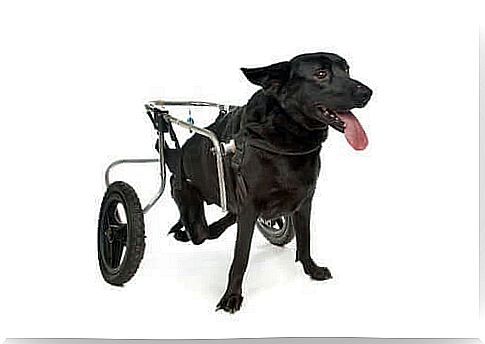Hip Dysplasia Care In Dogs

You’ve certainly heard of hip dysplasia in dogs. However, do you really know what it is, what its causes are and how it is treated? If you want to know more about hip dysplasia care in dogs, be sure to read this article.
Hip dysplasia in dogs
This is a disease that affects the hip and its joints. As such, it occurs when there is a problem in the joint between the head of the femur and its corresponding cavity in the hip.
When this happens, tissues degrade and dogs begin to experience discomfort when walking, which results in lameness.
Hip dysplasia in dogs usually appears at 4 or 5 months of age. As the pelvis increases in size, the disease tends to get worse.
There are several different degrees of dysplasia. According to the Orthopedic Foundation for Animals (OFA), each type of diagnosis will require a specific type of treatment.
Main causes
There is no doubt that there is a genetic factor behind this disease. However, there are also other important aspects, such as:
- Inadequate nutrition: lack of nutrients or excess protein.
- Overweight
- Excessive or inappropriate exercise.
- Size: much more common in medium and large dogs.
- Specific Dog Breeds: There are certain breeds, such as the German Shepherd, Neapolitan Mastiff and Golden Retriever, which are more likely to suffer from this disease.

Hip dysplasia care in dogs: diagnosis
There are several symptoms that can indicate hip dysplasia in dogs. Among them, the most frequent ones are lameness, difficulty in getting up or standing.
If we notice any of these symptoms, we should see a veterinarian, who will certainly perform an x-ray to confirm the diagnosis.
Hip dysplasia care in dogs: treatment
As we have already said, there are several types of treatment depending on the degree of development of the disease. Generally, most treatments aim to reduce effects or alleviate future symptoms.
However, the key to the success of most treatments is early diagnosis. After all, it will be easier to treat the animal the sooner the condition is detected.
In general, we can talk about preventive or conservative treatment, which includes dog physiotherapy, use of wheelchairs or hip supports. These devices have mechanisms that stabilize the hip, preventing atrophy and stimulating muscle activity in the affected area.

There is also a treatment that we could call medical or pharmacological, especially suitable for older animals. After all, in these animals dysplasia tends to be already advanced and the risk of surgery is greater.
In these cases, anti-inflammatory drugs can be administered to reduce pain. It is also common to combine them with chondroprotectors, a nutritional supplement that promotes cartilage hydration and delays the onset of various symptoms.
Finally, surgical treatment can also be used, which includes various procedures aimed at improving the affected area.
A valid option may be total joint replacement with a hip prosthesis. This option is definitive, but it also comes at a much higher cost.
Conclusion
Among the care we can offer our dog, the most important is to monitor the animal’s weight with a controlled diet, to avoid overloading the affected joints.
We must also control exercise, which must be moderate and regular over time. With all these tips, it may not be possible to end the disease, but let’s ensure that the dog, despite everything, has a good quality of life.









